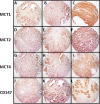Monocarboxylate transporter 4 (MCT4) and CD147 overexpression is associated with poor prognosis in prostate cancer
- PMID: 21787388
- PMCID: PMC3157459
- DOI: 10.1186/1471-2407-11-312
Monocarboxylate transporter 4 (MCT4) and CD147 overexpression is associated with poor prognosis in prostate cancer
Abstract
Background: Monocarboxylate transporters (MCTs) are transmembrane proteins involved in the transport of monocarboxylates across the plasma membrane, which appear to play an important role in solid tumours, however the role of MCTs in prostate cancer is largely unknown. The aim of the present work was to evaluate the clinico-pathological value of monocarboxylate transporters (MCTs) expression, namely MCT1, MCT2 and MCT4, together with CD147 and gp70 as MCT1/4 and MCT2 chaperones, respectively, in prostate carcinoma.
Methods: Prostate tissues were obtained from 171 patients, who performed radical prostatectomy and 14 patients who performed cystoprostatectomy. Samples and clinico-pathological data were retrieved and organized into tissue microarray (TMAs) blocks. Protein expression was evaluated by immunohistochemistry in neoplastic (n = 171), adjacent non-neoplastic tissues (n = 135), PIN lesions (n = 40) and normal prostatic tissue (n = 14). Protein expression was correlated with patients' clinicopathologic characteristics.
Results: In the present study, a significant increase of MCT2 and MCT4 expression in the cytoplasm of tumour cells and a significant decrease in both MCT1 and CD147 expression in prostate tumour cells was observed when compared to normal tissue. All MCT isoforms and CD147 were expressed in PIN lesions. Importantly, for MCT2 and MCT4 the expression levels in PIN lesions were between normal and tumour tissue, which might indicate a role for these MCTs in the malignant transformation. Associations were found between MCT1, MCT4 and CD147 expressions and poor prognosis markers; importantly MCT4 and CD147 overexpression correlated with higher PSA levels, Gleason score and pT stage, as well as with perineural invasion and biochemical recurrence.
Conclusions: Our data provides novel evidence for the involvement of MCTs in prostate cancer. According to our results, we consider that MCT2 should be further explored as tumour marker and both MCT4 and CD147 as markers of poor prognosis in prostate cancer.
Figures



Similar articles
-
Basigin (CD147) is the target for organomercurial inhibition of monocarboxylate transporter isoforms 1 and 4: the ancillary protein for the insensitive MCT2 is EMBIGIN (gp70).J Biol Chem. 2005 Jul 22;280(29):27213-21. doi: 10.1074/jbc.M411950200. Epub 2005 May 24. J Biol Chem. 2005. PMID: 15917240
-
Co-expression of CD147/EMMPRIN with monocarboxylate transporters and multiple drug resistance proteins is associated with epithelial ovarian cancer progression.Clin Exp Metastasis. 2010 Dec;27(8):557-69. doi: 10.1007/s10585-010-9345-9. Epub 2010 Jul 24. Clin Exp Metastasis. 2010. PMID: 20658178
-
Prognostic significance of lactate/proton symporters MCT1, MCT4, and their chaperone CD147 expressions in urothelial carcinoma of the bladder.Urology. 2014 Jul;84(1):245.e9-15. doi: 10.1016/j.urology.2014.03.031. Epub 2014 May 22. Urology. 2014. PMID: 24857275
-
Prognostic Indications of Elevated MCT4 and CD147 across Cancer Types: A Meta-Analysis.Biomed Res Int. 2015;2015:242437. doi: 10.1155/2015/242437. Epub 2015 Dec 8. Biomed Res Int. 2015. PMID: 26779534 Free PMC article. Review.
-
The proton-linked monocarboxylate transporter (MCT) family: structure, function and regulation.Biochem J. 1999 Oct 15;343 Pt 2(Pt 2):281-99. Biochem J. 1999. PMID: 10510291 Free PMC article. Review.
Cited by
-
Role of monocarboxylate transporters in the diagnosis, progression, prognosis, and treatment of prostate cancer.Turk J Urol. 2020 Nov;46(6):413-418. doi: 10.5152/tud.2020.20278. Epub 2020 Aug 20. Turk J Urol. 2020. PMID: 32833619 Free PMC article. Review.
-
Comprehensive Analysis of the Relationship Between Metabolic Reprogramming and Immune Function in Prostate Cancer.Onco Targets Ther. 2021 May 18;14:3251-3266. doi: 10.2147/OTT.S304298. eCollection 2021. Onco Targets Ther. 2021. PMID: 34040390 Free PMC article.
-
In vitro and in vivo prostate cancer metastasis and chemoresistance can be modulated by expression of either CD44 or CD147.PLoS One. 2012;7(8):e40716. doi: 10.1371/journal.pone.0040716. Epub 2012 Aug 3. PLoS One. 2012. PMID: 22870202 Free PMC article.
-
A glycolytic phenotype is associated with prostate cancer progression and aggressiveness: a role for monocarboxylate transporters as metabolic targets for therapy.J Pathol. 2015 Aug;236(4):517-30. doi: 10.1002/path.4547. J Pathol. 2015. PMID: 25875424 Free PMC article.
-
Nutrient transporters: connecting cancer metabolism to therapeutic opportunities.Oncogene. 2023 Mar;42(10):711-724. doi: 10.1038/s41388-023-02593-x. Epub 2023 Feb 4. Oncogene. 2023. PMID: 36739364 Free PMC article. Review.
References
-
- Semenza GL, Artemov D, Bedi A, Bhujwalla Z, Chiles K, Feldser D, Laughner E, Ravi R, Simons J, Taghavi P, Zhong H. The metabolism of tumours: 70 years later. Novartis Found Symp. 2001;240:251–260. - PubMed
Publication types
MeSH terms
Substances
LinkOut - more resources
Full Text Sources
Other Literature Sources
Medical
Molecular Biology Databases
Research Materials
Miscellaneous

